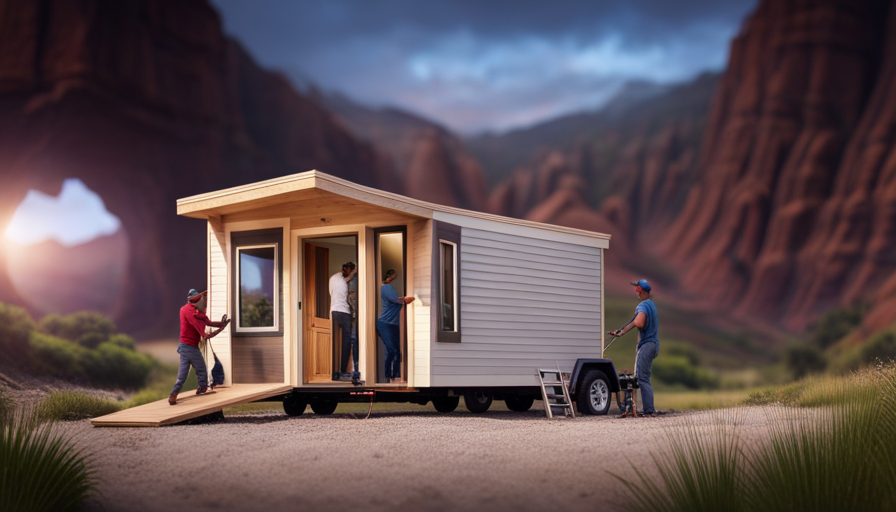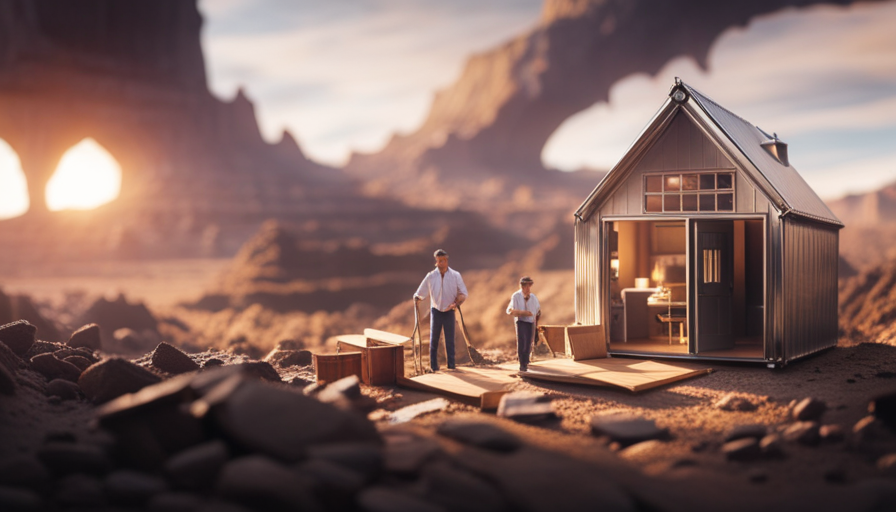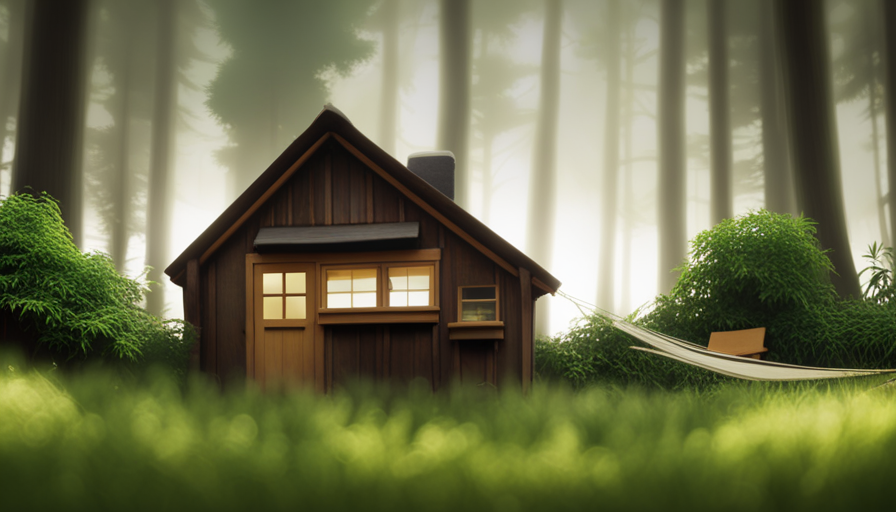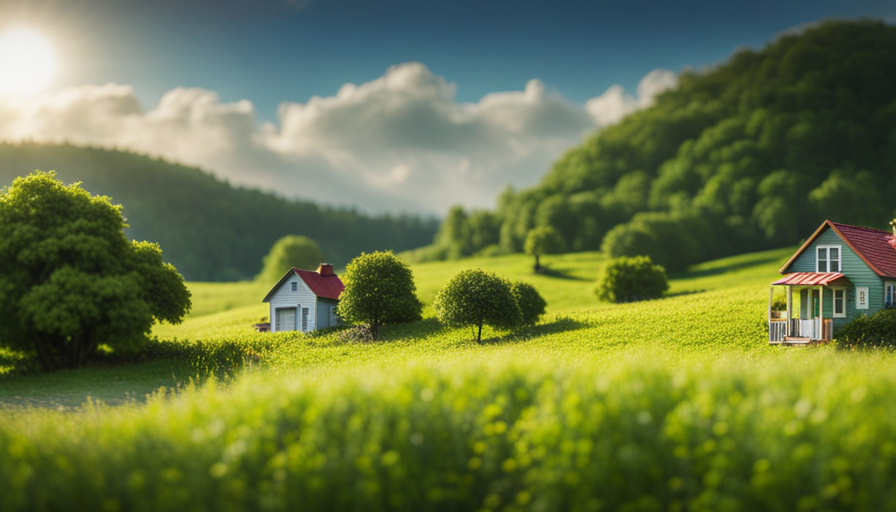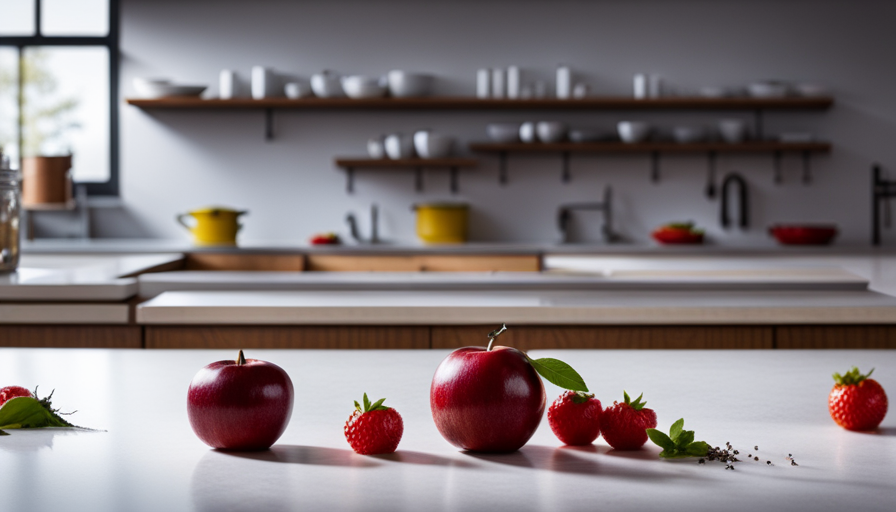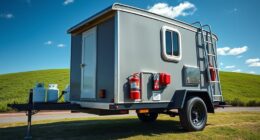Placing two opposing elements next to each other often reveals the significant distinctions between them, capturing the attention and curiosity of the audience. This is the exact charm of building a small house on wheels – it showcases a juxtaposition of mobility and comfort, minimalism and functionality.
Imagine owning a home that can travel with you, providing the freedom to explore new landscapes while still offering the comforts of a cozy abode. In this article, I will guide you through the process of building your very own tiny house on wheels.
With careful research and planning, you will learn how to design and layout your space efficiently. Gather the necessary materials and tools, and follow step-by-step instructions to construct a sturdy foundation and frame.
Plumbing and electrical systems may seem daunting, but fear not – I will break it down for you.
We will discuss furniture and appliances, ensuring you make the most out of limited space. Personalization options will be explored, allowing you to add your unique touch.
Safety and legal considerations are crucial, and I will provide you with a comprehensive guide.
So, let’s embark on this exciting journey of building a tiny house on wheels, and discover the perfect balance between mobility and comfort.
Key Takeaways
- Research, planning, and budgeting are essential for building a tiny house on wheels.
- Gathering materials and tools, including affordable and sustainable options, is necessary.
- Proper installation of the foundation, frame, insulation, plumbing, and electrical systems is crucial.
- Customization options, energy-efficient appliances, and regular maintenance are important for a functional and personalized tiny house.
Research and Planning
Now let’s dive into the exciting world of researching and planning your very own tiny house on wheels! When it comes to building a tiny house, the first step is to gather all the necessary information through various research methods.
Start by exploring online resources, joining forums and communities, and reading books and articles about building tiny houses on wheels. These sources will provide you with valuable insights, tips, and tricks from experienced individuals who’ve already embarked on this journey.
Once you have gathered enough knowledge, it’s time to move on to the next important aspect of planning – budgeting. Determine how much you’re willing to spend on your tiny house and create a detailed budget. Consider all the necessary expenses such as materials, tools, permits, and any professional assistance you might need. Look for budgeting strategies like recycling and repurposing materials, as well as considering alternative energy sources to reduce long-term costs.
With your research methods and budgeting strategies in place, you’re now ready to move on to the next section, which focuses on designing and laying out your tiny house. By carefully considering every aspect of the design, from the layout to the storage solutions, you can create a functional and comfortable living space that meets your needs.
Design and Layout
Begin by envisioning the perfect layout for your compact dream home on wheels, ensuring every square inch is optimized for functionality and comfort. When designing and planning the layout of your tiny house on wheels, it is important to consider design principles and space optimization techniques to make the most of the limited space available.
To help you visualize your ideas, consider creating a table with three columns and four rows. In the first column, list the different areas or rooms you want in your tiny house, such as a kitchen, bathroom, living area, and sleeping area. In the second column, describe the specific features and appliances you want to include in each area. And in the third column, jot down any additional notes or ideas you have for each space.
This table will serve as a visual representation of your design and help you organize your thoughts. By considering the size and layout of each area, as well as the placement of windows and doors, you can ensure an efficient and functional design.
Once you have finalized your layout and design, you can move on to gathering the materials and tools needed for the construction of your tiny house on wheels.
Gather Materials and Tools
To start building my tiny house on wheels, I need to create a materials list. This will help me stay organized and ensure I have everything I need. I’ll also focus on sourcing affordable and sustainable materials to reduce costs and have a positive impact on the environment. Additionally, I’ll gather all the necessary tools and equipment, such as a saw, drill, and measuring tape, to ensure I have everything I need to begin construction.
Create a materials list
Creating a materials list is crucial when building your own tiny house on wheels, as it allows you to estimate the cost and ensure you have everything you need, making your dream home more attainable.
To help you get started, here are three key items to include in your materials list:
-
Framing materials: Choose sturdy, lightweight materials like lumber or steel for the frame of your tiny house. Consider sourcing sustainable materials, such as reclaimed wood or recycled metal, to reduce environmental impact.
-
Insulation: Proper insulation is essential for maintaining a comfortable temperature inside your tiny house. Look for cost-effective alternatives like recycled denim or cellulose insulation, which provide excellent thermal performance.
-
Exterior materials: Consider using durable, weather-resistant materials for the exterior of your tiny house. Options include fiber cement siding, metal panels, or even reclaimed wood for a rustic look.
By sourcing affordable and sustainable materials for your tiny house, you can save money and reduce your ecological footprint.
Source affordable and sustainable materials
When sourcing materials for your DIY tiny home project, you’ll discover that affordable and sustainable options not only save you money but also contribute to a greener future. It’s important to consider eco-friendly alternatives that minimize your environmental impact. One option is to use reclaimed materials, such as salvaged wood or recycled windows, which can add character to your tiny house while reducing waste. Additionally, you can explore affordable options like bamboo flooring, which is a renewable resource that offers durability and aesthetic appeal. Another eco-friendly choice is insulation made from recycled denim or sheep’s wool, providing both thermal efficiency and sustainability. By sourcing affordable and sustainable materials, you can create a tiny house that aligns with your values and budget. In the next section, we’ll discuss how to gather the necessary tools and equipment for your project.
Gather necessary tools and equipment
Don’t forget to round up all the essential tools and equipment you’ll need to tackle this project like a pro! Gathering the necessary tools, equipment, and materials is crucial for a successful build. Here are the items you should have on hand:
-
Power tools: A circular saw, a cordless drill, and a jigsaw will be your best friends throughout the construction process.
-
Hand tools: A hammer, a tape measure, a level, and a set of screwdrivers are essential for precise measurements and installation.
-
Safety gear: Don’t skimp on safety! Invest in a good pair of work gloves, safety glasses, and a dust mask to protect yourself during the construction.
-
Ladders and scaffolding: Depending on the height of your tiny house, you may need a sturdy ladder or scaffolding to reach high areas safely.
-
Budgeting and cost estimation: Keep track of your expenses and create a detailed budget to ensure you stay within your means.
With all the necessary tools and equipment in place, it’s time to move on to building the foundation and frame.
Building the Foundation and Frame
Building the foundation and frame is an exciting and rewarding step in constructing your own tiny house on wheels. This is where you lay the groundwork for your entire project, ensuring a strong and sturdy structure.
When it comes to building the foundation, there are several techniques you can choose from. One popular method is using a trailer as the base, which provides mobility and stability. Make sure to secure the trailer properly and reinforce any weak spots.
Next, you’ll need to frame the walls and roof. This involves measuring and cutting the lumber to the appropriate dimensions and securing them together using nails or screws.
Insulation is an important consideration for your tiny house on wheels. You’ll want to choose an insulation option that’s lightweight, durable, and provides adequate thermal protection. Common choices include fiberglass, spray foam, and rigid foam insulation. Install the insulation between the wall studs and roof rafters, ensuring a tight fit to prevent air leakage.
With the foundation and frame complete, it’s time to move on to the next step: plumbing and electrical systems. These essential components will provide you with the comforts of a traditional home while on the road.
Plumbing and Electrical Systems
To ensure a comfortable and functional living space, you’ll need to know how to set up the plumbing and electrical systems in your tiny house on wheels. But have you considered how these systems will make your life easier on the road? Proper plumbing maintenance is essential to avoid leaks and ensure a steady water supply. Installing a water tank and connecting it to the kitchen and bathroom fixtures will allow you to have running water wherever you go. Additionally, a greywater system can be set up to collect and reuse wastewater, making your tiny house more sustainable.
When it comes to electrical safety, it’s crucial to have a solid understanding of wiring and circuitry. Planning the electrical layout and installing outlets strategically will make it easier to power your appliances and devices. It’s necessary to use the appropriate wire gauge and circuit breakers to prevent overloading the system. Implementing a solar power system can provide you with a renewable energy source, reducing your reliance on external power.
Here is a table summarizing the key components of the plumbing and electrical systems:
| Plumbing System | Electrical System |
|---|---|
| Water tank | Wiring |
| Kitchen and bathroom fixtures | Outlets |
| Greywater system | Solar power system |
Now that we have covered the plumbing and electrical systems, let’s move on to the next step: interior and exterior finishes, where we will explore how to transform your tiny house into a cozy and personalized space.
Interior and Exterior Finishes
Make your tiny house on wheels truly feel like home by adding your personal touch to the interior and exterior finishes. When it comes to the interior finishes, you have the opportunity to create a cozy and inviting space. Consider using natural materials such as wood or bamboo for the flooring, as it adds warmth and character to the space.
For the walls, you can choose to paint them in your favorite colors or use wallpaper to add texture and visual interest. Don’t forget to install proper lighting fixtures that not only provide adequate illumination but also enhance the overall ambiance of the space.
Moving on to the exterior finishes, you have the chance to make a statement with your tiny house on wheels. Opt for a durable and weather-resistant siding material such as vinyl or metal to protect your home from the elements. You can also add a pop of color by painting the exterior walls or using decorative accents such as window shutters or flower boxes.
Additionally, consider adding outdoor lighting to create a welcoming atmosphere and ensure safety during the evening hours.
Now that you have put the finishing touches on your tiny house on wheels, it’s time to move on to the next step of furnishing and equipping your space with the right furniture and appliances.
Furniture and Appliances
Now that we have discussed the various interior and exterior finishes for your tiny house on wheels, let’s move on to the next important aspect: furniture and appliances. When it comes to selecting furniture for your tiny house, it is crucial to prioritize functionality and space-saving designs. Opt for multipurpose furniture such as sofa beds or coffee tables with hidden storage compartments. Additionally, consider the size and scale of the furniture to ensure it fits well within the limited space.
In terms of appliances, energy efficiency should be a top priority. Look for compact and energy-efficient options that will not only save space but also reduce your energy consumption. This will help you maintain a sustainable and eco-friendly lifestyle while living in your tiny house.
To help you envision the possibilities, here is a table showcasing some furniture and appliance options for your tiny house:
| Furniture | Appliances |
|---|---|
| Folding table | Compact dishwasher |
| Wall-mounted desk | Mini fridge |
| Murphy bed | Induction cooktop |
| Storage ottoman | Washer-dryer combo |
With the right furniture selection and energy-efficient appliances, you can make the most of your tiny house on wheels. Now, let’s move on to the next section, where we will explore the exciting realm of customization and personalization.
Customization and Personalization
Take a moment to consider how you can infuse your own unique style and personality into every corner of your compact mobile abode. When it comes to customization options and personalization techniques for your tiny house on wheels, the possibilities are endless. Here are five ideas to inspire you:
-
Paint and wallpaper: Choose colors and patterns that reflect your personal taste and create a cozy atmosphere. Don’t be afraid to experiment with bold or vibrant shades to make a statement.
-
Creative storage solutions: Maximize the limited space by incorporating clever storage solutions like built-in shelves, hidden compartments, and multi-purpose furniture. This will not only add functionality but also showcase your organizational skills.
-
Custom furniture: Consider having custom-made furniture that perfectly fits your tiny house. This way, you can optimize the space and tailor it to your specific needs and preferences.
-
Artwork and decorations: Hang your favorite artwork, family photos, or decorative items on the walls to add a personal touch. It’ll make your tiny house feel like a home.
-
DIY projects: Get creative and embark on DIY projects to add unique features to your tiny house. Whether it’s building a custom bookshelf or creating a personalized headboard, these projects’ll showcase your skills and make your tiny house truly one-of-a-kind.
Now that you’ve got some ideas for customizing and personalizing your tiny house on wheels, it’s important to consider safety and legal considerations to ensure a smooth and secure experience.
Safety and Legal Considerations
Ensuring the safety and legality of your mobile abode is essential for a worry-free and enjoyable tiny house living experience. When building a tiny house on wheels, it’s important to adhere to safety regulations to protect yourself and others. These regulations may vary depending on your location, so it’s crucial to research and understand the specific requirements in your area.
Some common safety regulations include proper insulation, adequate ventilation, secure anchoring, and electrical system compliance. Meeting these regulations will not only provide a safe living environment but also give you peace of mind knowing that your tiny house is built to code.
In addition to safety regulations, it’s important to consider insurance requirements for your tiny house on wheels. While insuring a tiny house can be more challenging than insuring a traditional home, it’s not impossible. There are insurance companies that specialize in tiny house coverage, and they can help you find a policy that suits your needs. It’s essential to have proper insurance coverage to protect your investment and provide financial security in case of accidents or unforeseen events.
Moving forward, once you have ensured the safety and legality of your tiny house, the next step is to consider maintenance and upkeep.
Maintenance and Upkeep
When it comes to maintaining and keeping up with my tiny house on wheels, I’ve found that developing a routine maintenance plan is crucial.
This plan includes regular cleaning, checking for any signs of wear and tear, and addressing any necessary repairs or replacements. Additionally, I make sure to keep an inventory of the necessary items for repairs and replacements, so I’m always prepared.
Lastly, I find it important to stay organized and declutter regularly to ensure that my tiny house remains functional and clutter-free.
Develop a routine maintenance plan
Maintain your mobile micro-home by making a monthly maintenance plan. Developing a cleaning schedule is crucial to keep your tiny house on wheels in top condition. Create a routine for cleaning the interior, including dusting surfaces, vacuuming floors, and wiping down appliances. Don’t forget to clean the exterior as well, removing any dirt or debris that may have accumulated. Implement preventative measures to avoid potential issues. Regularly inspect the plumbing, electrical systems, and HVAC to identify any signs of wear or damage. Additionally, make sure to check the tires, brakes, and hitch to ensure they are in good working order. By staying on top of regular maintenance tasks, you can prevent major issues and prolong the lifespan of your tiny house. Keep an inventory of necessary repairs and replacements to stay prepared for any unexpected challenges. Transitioning to the next section, it’s important to be aware of the repairs and replacements your mobile micro-home may require.
Keep an inventory of necessary repairs and replacements
Make sure you keep track of all the repairs and replacements needed for your mobile micro-home, so you can be prepared for any unexpected challenges that may arise.
Maintaining an inventory of necessary repairs and replacements is crucial for the smooth operation of your tiny house on wheels. By documenting each repair or replacement, you can easily identify patterns or recurring issues, allowing you to proactively address them.
Additionally, having an inventory will help you stay organized and ensure that you have the necessary materials and tools on hand when needed. Whether it’s a leaky faucet, a broken hinge, or a malfunctioning electrical component, keeping track of these items will save you time and effort in the long run.
Transitioning into the subsequent section about ‘stay organized and declutter regularly,’ it’s important to remember that a clutter-free living space is essential for a functional tiny house.
Stay organized and declutter regularly
To keep your mobile micro-home functioning efficiently, it’s crucial to stay organized and regularly declutter your living space. Living in a tiny house on wheels means that every inch of space counts, so it’s important to keep things tidy and clutter-free.
One way to achieve this is by having designated storage areas for different items. Use bins, baskets, and shelves to keep things in order and easily accessible.
Regularly go through your belongings and get rid of anything that you don’t need or use anymore. This will help create more space and make your tiny house feel less cramped.
Additionally, keeping a schedule for cleaning and decluttering will ensure that you stay on top of things and maintain a neat and organized living environment.
Frequently Asked Questions
How do I choose the right location to park my tiny house on wheels?
Choosing the right location to park a tiny house on wheels is crucial for a successful and enjoyable living experience. When selecting a parking spot, there are several factors to consider. These include safety, accessibility to amenities, local regulations, and proximity to work or social activities.
To find legal and affordable parking options, research local zoning laws, reach out to RV parks, tiny house communities, or even private landowners who may allow you to park.
What are some common challenges that people face when building a tiny house on wheels?
When it comes to building a tiny house on wheels, there are a few common challenges that I’ve encountered. First, obtaining the necessary building permits can be a time-consuming process.
Additionally, choosing the right trailer size is crucial, as it determines the overall dimensions of your tiny house. From there, challenges can include insulation, plumbing, and electrical work.
However, with careful planning and research, these obstacles can be overcome, resulting in a cozy and functional tiny home.
Can I legally live in a tiny house on wheels full-time?
Yes, it’s possible to legally live in a tiny house on wheels full-time. However, it depends on the legal requirements and zoning restrictions in your area. It’s important to research and comply with the specific regulations set by your local government. Some areas may require obtaining permits, meeting certain safety standards, or locating in designated areas. Consulting with local authorities and professionals can help ensure you’re in compliance with all necessary regulations.
How do I ensure my tiny house on wheels is properly insulated for all seasons?
To ensure my tiny house on wheels is properly insulated for all seasons, I would use various insulating techniques and energy-efficient materials.
I would start by insulating the walls, roof, and floor with high-quality insulation. Additionally, I would seal any gaps or cracks to prevent air leakage.
To further enhance insulation, I would consider using double-pane windows and insulated doors.
By employing these methods, my tiny house would be well-insulated and energy-efficient year-round.
What are some alternative energy options for powering a tiny house on wheels?
One alternative energy option for powering a tiny house on wheels is solar power. For example, let’s say you install solar panels on the roof of your tiny house. These panels will capture sunlight and convert it into electricity, which can power your appliances and lighting.
Another option is using wind turbines. By harnessing the power of wind, you can generate electricity to meet your energy needs. Both solar power and wind turbines are sustainable and eco-friendly choices for powering your tiny house on wheels.
Conclusion
In conclusion, building a tiny house on wheels yourself is a rewarding and fulfilling project.
From researching and planning to customizing and personalizing, the process can be both challenging and exciting.
By following a step-by-step approach, you can create a cozy and functional space that fits your needs and preferences.
But remember, safety and legal considerations are crucial, so make sure to comply with regulations.
So why wait? Are you ready to embark on this incredible journey and create your dream tiny house on wheels?
Hi, I’m Emma. I’m the Editor in Chief of Tiny House 43, a blog all about tiny houses. While tree houses are often associated with childhood, they can be the perfect adult retreat. They offer a cozy space to relax and unwind, surrounded by nature. And since they’re typically built on stilts or raised platforms, they offer stunning views that traditional homes simply can’t match. If you’re looking for a unique and romantic getaway, a tree house tiny house might just be the perfect option.
